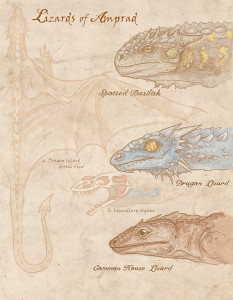An essay by Prof. Ann A. Shipwell, as provided by K.C. Shaw
Art by Leigh Legler
When I was a little girl, my friends and I were encouraged to collect flowers and ferns. In this way, we learned techniques for plant preservation, discovered which plants grew around our village, and got fresh air and exercise. I daresay our parents were happy to have us out from underfoot as well.
In my case, these collecting excursions developed into a love of both botany and exploration which has shaped my adult life. But even before I placed my first flower between sheets of waxed paper, I was a keen observer of lizards. As you may know, the country of Amprad is home to over a dozen species of lizard, three of them unique to our islands. What you may not know is how easy it is to find these elegant creatures and learn all about them.
#
Even if you live in our great city of Nexa, you needn’t wait for a holiday to the countryside to start your observations. The Spotted Basilisk is common within the city. During the day, they bask on rooftops or other sunny spots, saving their energy for night-time prowls. Most basilisks are about the length of your own hand, not counting the tail. Their bumpy scales are brown or gray with yellow spots in rows along each side. These yellow spots warn other animals not to eat the basilisk–because this lizard has a natural poison in its blood.
As an example of the basilisk’s poison, I will share a story from when I was seven or eight years old. My brother and I had been sent to Nexa to stay with relatives over the summer, and one day my cousin Winnie and I happened upon a poor stray cat who had, I thought, been killed in such a way that it died standing up. The thin little body was absolutely stiff. Winnie, however, knew what had happened.
The cat, no doubt desperate for food, had bitten a basilisk. The poison had taken effect so quickly that the animal had not been able to hide before its muscles grew completely rigid. I examined it with interest. It had not had a fatal dose, which would stop the muscles of the heart and diaphragm (which enables us all to breathe), but its pulse was dangerously slow and its breathing shallow.
I picked up the cat, which felt like a carved wooden toy covered with fur. Winnie and I took it back to her home, where we kept it comfortable and watched for any change. It took three whole days for the cat’s muscles to relax! It was terribly weak after its ordeal, but Winnie and I fed it with beef broth and other nourishing foods and I am happy to say that it recovered fully. It remained absolutely devoted to Winnie for the rest of its years and proved a fine mouser–but it would flee in terror from any reptile, no matter how harmless.
The spotted basilisk moves slowly, which makes it easy to catch. It becomes tame quite easily and thrives upon crickets, mice, and earthworms. Many people believe that the basilisk can paralyze merely by looking at someone, but of course that is nonsense. Only the true basilisk, a rare reptile that lives in the desert wastes of Pruiff, has a paralyzing gaze.
To read the rest of this story, check out the Mad Scientist Journal: Winter 2014 collection.
Professor Shipwell taught botany at the Rampark College in Hule for eight years before accepting a commission from the Amprad Botanical Gardens to travel and collect specimens for their collection. She was born in Bad Rock in Southern Amprad and attended Nexa University. In her spare time she trains Demon Bats to sing. She also knits.
K.C. Shaw’s fiction has appeared in numerous magazines and anthologies, including Beneath Ceaseless Skies and Daily Science Fiction. Visit her website at http://kcshaw.net.
Leigh’s professional title is “illustrator,” but that’s just a nice word for “monster-maker,” in this case. More information about them can be found at http://leighlegler.carbonmade.com/.
Follow us online:
